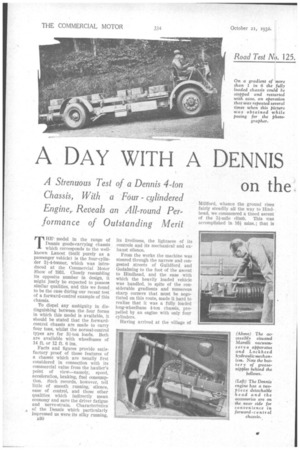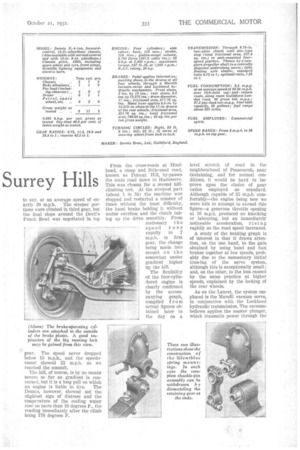A DAY WITH A DENNIS
Page 56

Page 57

Page 58

If you've noticed an error in this article please click here to report it so we can fix it.
on the Surrey Hills
THE model in the range of Dennis goods-carrying chassis which corresponds to the wellknown Lancet (built purely as a passenger vehicle) is the four-cylinder 33-4-tonner, which was introduced at the Commercial Motor Show of 131. Closely resembling its opposite number in design, it might justly be expected to possess similar qualities, and this we found. to be the case during our recent test of a forward-control example of this chassis.
To dispel any ambiguity in distinguishing between the four forms in which this model is available, it should be stated that the forwardcontrol chassis are made to carry four tons, whilst the normal-control types are for 33-ton loads. Both are available with wheelbases of 14 ft. or 12 ft. 6 ins.
Pacts and figures provide satisfactory proof of those features of a chassis which are usually first considered in connection with its commercial value from the haulier's point of view—namely, speed, acceleration, braking, fuel consumption. Such records, however, tell little of smooth running, silence, ease of control, and those other qualities which indirectly mean economy and save the driver fatigue• and nerve-strain. Characteristics of the Dennis which particularly impressed us were its silky running,
530 its liveliness, the lightness of its controls and its mechanical and exhaust silence.
From the works the machine was steered through the narrow and congested streets of Guildford and Godalming to the foot of the ascent to Hindhead, and the ease with .which the heavily loaded vehicle was handled, in spite of the considerable gradients and numerous sharp corners that must be .negotiated on this route, made it hard to realize that it was a fully loaded long-wheelbase 4-ton chassis, propelled by an engine with only four cylinders.
Having arrived. at the village of
Millford, whence the ground rises fairly steadily all the way to Hind head, we commenced a timed ascent of. the 53-mile climb. This was accomplished in 16.mins.; that is
to say, at an average speed of exactly 20 m.p.h. The steeper portions were climbed in third gear, but the final slope around the Devil's Punch Bowl was negotiated in top gear. The speed never dropped below 15 m.p.h., and the speedometer showed 22 m.p.h. as we reached the summit.
The hill, of course, is by no means severe so far as gradient is concerned, but it is a long pull on which an engine is liable to tire. The Dennis, however, showed not the slightest sign of distress and the temperature of the cooling water rose no more than 10 degrees F., the reading immediately after the climb being 176 degrees F. From the cross-roads at Hindhead, a steep and little-used road, known as Polecat Hill, by-passes the main road down to Haslemere. This was chosen for a second hillclimbing test. At the steepest part (about 1 in 51) the machine was stopped and restarted a number of times without the least difficulty, the hand brake holding it without undue exertion and the clutch taking up the drive smoothly. From stationary the speed rose rapidly to 7 m.p.h. in first gear, the change being made into second on the somewhat easier gradient higher up the hill.
The flexibility of the four-cylindered engine is clearly confirmed by the accompanying graph, compiled fr om actual figures obtained later in the day on a level stretch of road in the neighbourhood of Peasmarsh, near Godalming, and for normal conditions, it would be hard to improve upon the choice of gear ratios employed as standard. Although capable of 35 m.p.h. comfortably—the engine being new we were loth to attempt to exceed this figure—a generous throttle opening at 10 m.p.h. produced no knocking or labouring, but an immediately noticeable acceleration, rising rapidly as the road speed increased.
A study of the braking graph is of interest in that it draws attention, on the one hand, to the gain obtained by using hand and foot brakes together at low speeds, probably due to the momentary initial time-lag of the servo system, although this is exceptionally small; and, on the other, to the loss caused by the same practice at higher speeds, explained by the locking of the rear wheels.
As on the Lancet, the system employed is the Marelli vacuum servo, in conjunction with the Lockheed hydraulic transmission. The vacuumbellows applies the master plunger, which transmits power through the
medium of oil to a cylinder on each brake, the plungers being connected to the brake-shoe operating levers.
There is little doubt that on a consumption test—provided that the distances are the same—a climb and an equal descent require more fuel than does a level run, the low consumption on the down-grade not wholly compensating for the high consumption on the up-grade. For this reason our test of the Dennis must be regarded as a fairly easy one, it having been carried out along the London Road from just outside Guildford to the beginning of the Fairmile, on the Esher side of Cobham, and back—a distance of 18.6 miles. It included two brief hold-ups at a point where the road was under repair. The only hills of any consequence on this _route are those on each side of Cobham and that at the north-east side of Wisley Common. All were climbed in top gear.
Averaging almost 21 m.p.h, for the total 18.6 miles, the vehicle consumed exactly two gallons of petrol, which gives the creditable figure of 9.3 m.p.g. The settings of the Zenith carburetter were found to be :—IVfain jet, 120; compensator, 135; slow-running jet, 60; and choke, 29.
There are numerous interesting features in this chassis, but consideration of space precludes more than a brief summary of the noteworthy points.
To deal with the engine first, it is mounted on rubber buffers at the rear and hung by Silentbloc-bushed links at the front. For accessibility on the forward-control models practically all the auxiliaries are situated on the near side. The cylinder head is detachable and comprises two separate castings ; renewable liners are employed and the floating gudgeon pins are retained by spring keeper-rings. The inlet valves are masked. A large tinned oil filter and cooling-unit is situated at the front of the engine, and an A.C. fuel pump raises petrol from the 35gallon tank on the near side of the frame to the carburetter.
The electrical equipment is of Scintilla manufacture and includes an electric horn and a stoplight. The switch and instrument board is attached to the steering column, where it is under the driver's eye and extremely accessible.
Silentbloc bushes provide an insulating mounting for the radiator B32 and a fine gauze protects it from stones.
Features of the transmission are the use of a torsional vibration damper in the propeller shaft and of three universal joints. The centre of the shaft runs in a bearing which is supported on a crossmember through the medium, again, of Silentbloc bushes. It is undoubtedly the attention that has been paid to the elimination of vibration and the insulation of moving parts that is responsible for the silky running of the complete vehicle. An underslung worm transmits the power to the back axle, and the removal of the complete differential assembly is a simple matter.
The torsional vibration damper is situated just behind the central propeller-shaft bearing. It consists of a pair of small flywheels running between friction discs, against which they are kept in contact by springs, the degree of friction being sufficient to afford the desired shock-absorption effect. It will be noticed from reference to an accompanying illustration that the spring shackles are built up—a system of construction which simplifies the employment of Silentbloc bushes for yet another purpose. For the fixed ends of the springs a detachable steel split-bush enables the spring to be dismantled without disturbing the shackle pin.
Protected by an easily detachable cover, the servo cylinder and oil tank, in which is the master plunger, are accessibly situated on the offside frame-member, whilst the individual brake-operating cylinders are mounted on the backs of the brake-shoe plates. Accompanying illustrations depict both ; in that which shows the servo mechanism, one of the grouped-nipple batteries can be discerned at the rear of the bellows.
A detail worthy of mention is the spare-wheel holder. This consists of a left and right-hand-threaded screw on which work two steel blocks, arranged to grip the inner edge of the wheel disc. Thus a few turns of the screw, operated by the wheel brace, releases or grips the spare wheel.
Finally, a word of praise must be written for the really excellent instruction book on this chassis that has recently been issued by Dennis Brothers, Ltd. Well illustrated, and dealing, clearly.and in a practical manner, with every component of the chassis, it is as representative of Dennis methods as is the chassis itself.




































































































